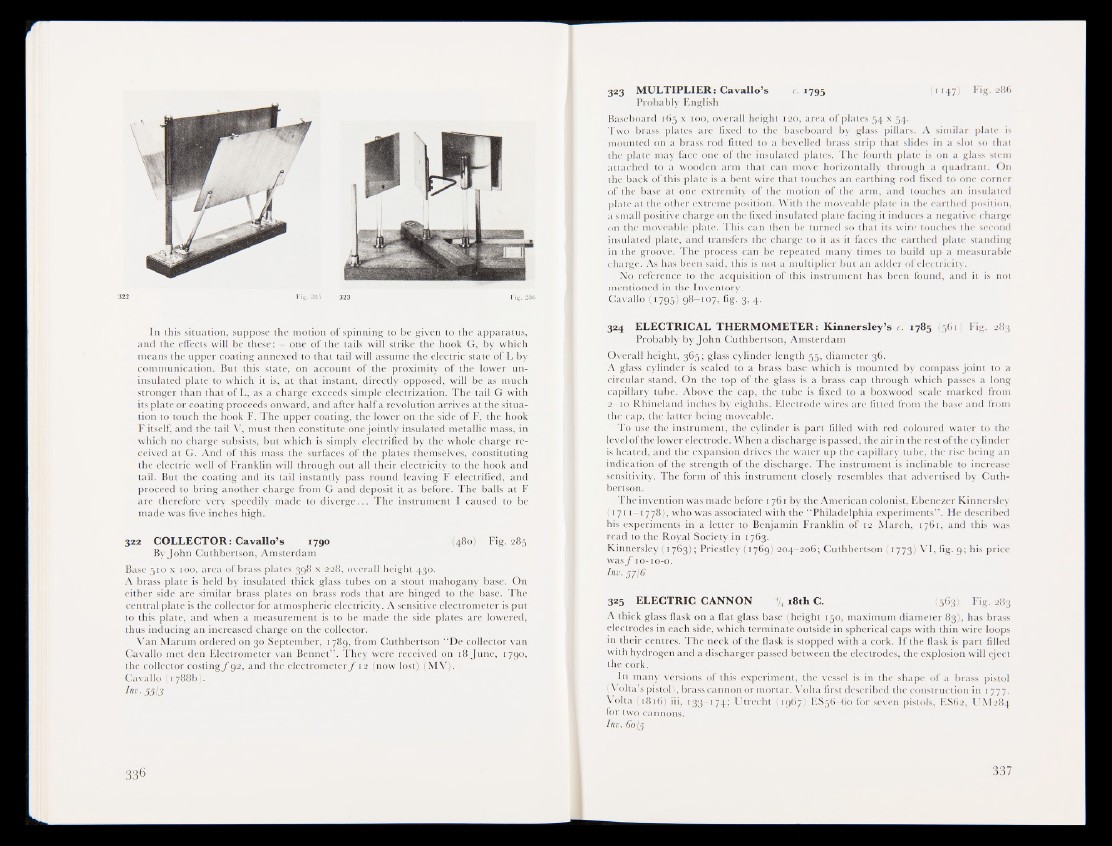
In this situation, suppose the motion of spinning to be given to the apparatus,
and the effects will be these®- one of the tails will strike the hook G, by which
means the upper coating annexed to that tail will assume the electric state of L by
communication. But this state, on account of the proximity of the lower uninsulated
plate to which it is, at that instant, directly opposed, will be as much
stronger than that of L, as a charge exceeds simple electrization. The tail G with
its plate or coating proceeds onward, and after half a revolution arrives at the situation
to touch the hook F. The upper coating, the lower on the side of F, the hook
F itself, and the tail V, must then constitute one jointly insulated metallic mass, in
which no charge subsists, but which is simply electrified by the whole charge received
at G. And of this mass the surfaces of the plates themselves, constituting
the electric well of Franklin will through out all their electricity to the hook and
tail. But the coating and its tail instantly pass round leaving F electrified, and
proceed to bring another charge from G and deposit it as before. The "balls at F
are therefore very speedily made to diverge... The instrument I caused to be
made was five inches high.
322 COLLECTOR: Cavallo’s 1790 (48cj| Fig- 2®3
By John Cuthbertson, Amsterdam
Base 510 x too, area of brass plates ..§98 x 228, overall height 430.
A brass plate is held by insulated thick glass tubes on a stout mahogany base. On
either side are similar brass plates on brass rods that are hinged to the base. The
central plate is the collector for atmospheric electricity. A sensitive electrometer is put
to this plate, and when a measurement is to be made the side plates are lowered,
thus inducing an increased charge on the collector.
Van Marum ordered on 30 September, 1789, from Cuthbertson “ De collector van
Cavallo met den Electrometer van Bennet” . They were received on 18 June, 1790,
the collector costing ƒ 92, and the electrometer ƒ 12 (now lost) (MV).
Cavallo (1788b).
9 55b
323 MULTIPLIER: Cavallo’s ■ *795
Probably English
1147) Fig. 286
Baseboard 165 x 100, overall height 120, area of plates 54 x 54.
Two brass plates are fixed to the baseboard by glass pillars. A similar plate is
mounted on a brass rod fitted to a bevelled brass strip that slides in a slot so that
the plate may face one of the insulated plates. The fourth plate is on a glass stem
attached to: a wooden arm that can move horizontally through a quadrant. On
the back of this plate is a bent wire that touches an earthing rod fixed to one corner
of the base at one extremity of the motion of the arm, and touches an insulated
plate at the other extreme position. With the moveable plate in the earthed position,
a small positive charge on the fixed insulated plate facing it induces a negative charge
on the moveable plate. This can then be turned so that its wire touches the second
insulated plate, and transfers the charge to it as it faces the earthed plate standing
in the groove. The process can be repeated many times to build up a measurable
charge. As has been said, this is not a multiplier but an adder of electricity.
No reference to the acquisition of this instrument has been found, and it is not
mentioned in the Inventory.
Cavallo;:; 1795'; 98-107, fig. 3, 4.
324 ELECTRICAL THERMOMETER: Kinnersley’s c. 1785 (561) Fig. 283
Probably by John Cuthbertson, Amsterdam
Overall height, 365; glass cylinder length 55, diameter 36.
A glass cylinder is sealed to a brass base which is mounted by compass joint to a
circular stand. On the top of the glass is a brass cap through which passes a long
capillary tube. Above the cap, the tube is fixed to a boxwood scale marked from
2-10 Rhineland inches by eighths. Electrode wires are fitted from the base and from
the cap, the latter being moveable.
To use the instrument, the cylinder is part filled with red coloured water to the
level of the lower electrode. When a discharge is passed, the air in the rest of the cylinder
isweated, and the expansion drives the water up the capillary tube, the rise being an
indication of the strength of the discharge. The instrument is inclinable to increase
sensitivity. The form of this instrument closely resembles that advertised by Cuthbertson.
The invention was made before 1761 by the American colonist, Ebenezer Kinnersley
fj 711—1778), who was associated with the “ Philadelphia experiments” . He described
his experiments in a letter to Benjamin Franklin of 12 March, 1761, and this was
read to the Royal Society in 1763.
Kinnersley (1763I ; Priestley (1769) 204—206; Cuthbertson (1773) VI, fig. g; his price
was ƒ 10-10-0.
InvMflW
325 ELECTRIC CANNON % 18th C. (563) Fig. 283
A thick glass flask on a flat glass base (height 150, maximum diameter 83), has brass
electrodes in each side, which terminate outside in spherical caps with thin wire loops
in their centres. The neck of the flask is stopped with a cork. If the flask is part filled
with hydrogen and a discharger passed between the electrodes, the explosion will eject
the cork.
In many versions of this experiment, the vessel is in the shape of a brass pistol
(Volta’s pistol), brass cannon or mortar. Volta first described the construction in 1777.
Volta (1816) iii, 133 174; Utrecht (1967) ES56-60 for seven pistols, ES62, UM284
for two cannons.
Inv. 6o/j